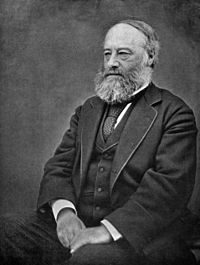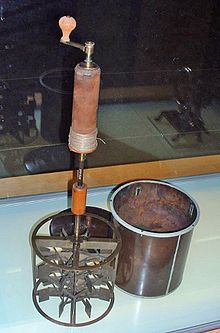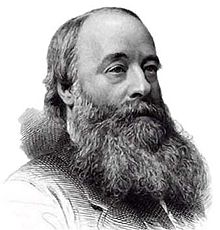James Prescott Joule FRS FRSE (/dʒuːl/;[1][2][a] 24 December 1818 – 11 October 1889) was an English physicist, mathematician and brewer, born in Salford, Lancashire. Joule studied the nature of heat, and discovered its relationship to mechanical work (see energy). This led to the law of conservation of energy, which in turn led to the development of the first law of thermodynamics. The SI derived unit of energy, the joule, is named after him.
He worked with Lord Kelvin to develop an absolute thermodynamic temperature scale, which came to be called the Kelvin scale. Joule also made observations of magnetostriction, and he found the relationship between the current through a resistor and the heat dissipated, which is also called Joule's first law. His experiments about energy transformations were first published in 1843.
James Prescott Joule | |
|---|---|
 | |
| Born | 24 December 1818 Salford, Lancashire, England |
| Died | 11 October 1889 (aged 70) |
| Citizenship | British |
| Known for | First law of thermodynamics Disproving caloric theory |
| Spouse(s) | Amelia Grimes (m. 1847; died 1854) |
| Children | Benjamin Arthur Alice Amelia Henry |
| Awards | Royal Medal (1852) Copley Medal (1870) Albert Medal (1880) |
| Scientific career | |
| Fields | Physics |
| Influences | John Dalton John Davies |
The mechanical equivalent of heat[edit]
Further experiments and measurements with his electric motor led Joule to estimate the mechanical equivalent of heat as 4.1868 joules per calorie of work to raise the temperature of one gram of water by one Kelvin.[b] He announced his results at a meeting of the chemical section of the British Association for the Advancement of Science in Cork in August 1843 and was met by silence.[7]
Joule was undaunted and started to seek a purely mechanical demonstration of the conversion of work into heat. By forcing water through a perforated cylinder, he could measure the slight viscous heating of the fluid. He obtained a mechanical equivalent of 770 foot-pounds force per British thermal unit (4,140 J/Cal). The fact that the values obtained both by electrical and purely mechanical means were in agreement to at least one order of magnitude was, to Joule, compelling evidence of the reality of the convertibility of work into heat.
Joule now tried a third route. He measured the heat generated against the work done in compressing a gas. He obtained a mechanical equivalent of 798 foot-pounds force per British thermal unit (4,290 J/Cal). In many ways, this experiment offered the easiest target for Joule's critics but Joule disposed of the anticipated objections by clever experimentation. Joule read his paper to the Royal Society on 20 June 1844,[8][9] but his paper was rejected for publication by the Royal Society and he had to be content with publishing in the Philosophical Magazine in 1845.[10] In the paper he was forthright in his rejection of the caloric reasoning of Carnot and Émile Clapeyron, a rejection partly theologically driven:
Joule here adopts the language of vis viva (energy), possibly because Hodgkinson had read a review of Ewart's On the measure of moving force to the Literary and Philosophical Society in April 1844.
Joule wrote in his 1844 paper:
In June 1845, Joule read his paper On the Mechanical Equivalent of Heat to the British Association meeting in Cambridge.[11] In this work, he reported his best-known experiment, involving the use of a falling weight, in which gravity does the mechanical work, to spin a paddle wheel in an insulated barrel of water which increased the temperature. He now estimated a mechanical equivalent of 819 foot-pounds force per British thermal unit (4,404 J/Cal). He wrote a letter to the Philosophical Magazine, published in September 1845 describing his experiment.[12]
In 1850, Joule published a refined measurement of 772.692 foot-pounds force per British thermal unit (4,150 J/Cal), closer to twentieth century estimates.[13]
Reception and priority[edit]
Much of the initial resistance to Joule's work stemmed from its dependence upon extremely precise measurements. He claimed to be able to measure temperatures to within 1⁄200 of a degree Fahrenheit (3 mK). Such precision was certainly uncommon in contemporary experimental physics but his doubters may have neglected his experience in the art of brewing and his access to its practical technologies.[14] He was also ably supported by scientific instrument-maker John Benjamin Dancer. Joule's experiments complemented the theoretical work of Rudolf Clausius, who is considered by some to be the coinventor of the energy concept.
Joule was proposing a kinetic theory of heat (he believed it to be a form of rotational, rather than translational, kinetic energy), and this required a conceptual leap: if heat was a form of molecular motion, why didn't the motion of the molecules gradually die out? Joule's ideas required one to believe that the collisions of molecules were perfectly elastic. Importantly, the very existence of atoms and molecules was not widely accepted for another 50 years.
Although it may be hard today to understand the allure of the caloric theory, at the time it seemed to have some clear advantages. Carnot's successful theory of heat engines had also been based on the caloric assumption, and only later was it proved by Lord Kelvin that Carnot's mathematics were equally valid without assuming a caloric fluid.
However, in Germany, Hermann Helmholtz became aware both of Joule's work and the similar 1842 work of Julius Robert von Mayer. Though both men had been neglected since their respective publications, Helmholtz's definitive 1847 declaration of the conservation of energy credited them both.
Also in 1847, another of Joule's presentations at the British Association in Oxford was attended by George Gabriel Stokes, Michael Faraday, and the precocious and maverick William Thomson, later to become Lord Kelvin, who had just been appointed professor of natural philosophy at the University of Glasgow. Stokes was "inclined to be a Joulite" and Faraday was "much struck with it" though he harboured doubts. Thomson was intrigued but sceptical.
Unanticipated, Thomson and Joule met later that year in Chamonix. Joule married Amelia Grimes on 18 August and the couple went on honeymoon. Marital enthusiasm notwithstanding, Joule and Thomson arranged to attempt an experiment a few days later to measure the temperature difference between the top and bottom of the Cascade de Sallanches waterfall, though this subsequently proved impractical.
Though Thomson felt that Joule's results demanded theoretical explanation, he retreated into a spirited defence of the Carnot-Clapeyron school. In his 1848 account of absolute temperature, Thomson wrote that "the conversion of heat (or caloric) into mechanical effect is probably impossible, certainly undiscovered"[15][16] – but a footnote signalled his first doubts about the caloric theory, referring to Joule's "very remarkable discoveries". Surprisingly, Thomson did not send Joule a copy of his paper but when Joule eventually read it he wrote to Thomson on 6 October, claiming that his studies had demonstrated conversion of heat into work but that he was planning further experiments. Thomson replied on the 27th, revealing that he was planning his own experiments and hoping for a reconciliation of their two views. Though Thomson conducted no new experiments, over the next two years he became increasingly dissatisfied with Carnot's theory and convinced of Joule's. In his 1851 paper, Thomson was willing to go no further than a compromise and declared "the whole theory of the motive power of heat is founded on two propositions, due respectively to Joule, and to Carnot and Clausius".
As soon as Joule read the paper he wrote to Thomson with his comments and questions. Thus began a fruitful, though largely epistolary, collaboration between the two men, Joule conducting experiments, Thomson analysing the results and suggesting further experiments. The collaboration lasted from 1852 to 1856, its discoveries including the Joule–Thomson effect, and the published results did much to bring about general acceptance of Joule's work and the kinetic theory.
Kinetic theory[edit]
Kinetics is the science of motion. Joule was a pupil of Dalton and it is no surprise that he had learned a firm belief in the atomic theory, even though there were many scientists of his time who were still skeptical. He had also been one of the few people receptive to the neglected work of John Herapath on the kinetic theory of gases. He was further profoundly influenced by Peter Ewart's 1813 paper On the measure of moving force.
Joule perceived the relationship between his discoveries and the kinetic theory of heat. His laboratory notebooks reveal that he believed heat to be a form of rotational, rather than translational motion.
Joule could not resist finding antecedents of his views in Francis Bacon, Sir Isaac Newton, John Locke, Benjamin Thompson (Count Rumford) and Sir Humphry Davy. Though such views are justified, Joule went on to estimate a value for the mechanical equivalent of heat of 1034 foot-pound from Rumford's publications. Some modern writers have criticised this approach on the grounds that Rumford's experiments in no way represented systematic quantitative measurements. In one of his personal notes, Joule contends that Mayer's measurement was no more accurate than Rumford's, perhaps in the hope that Mayer had not anticipated his own work.
Joule has been attributed with explaining the sunset green flash phenomenon in a letter to the Manchester Literary and Philosophical Society in 1869; actually, he merely noted (with a sketch) the last glimpse as bluish green, without attempting to explain the cause of the phenomenon.[17]
See also[edit]
- Joule expansion
- Joule's second law
- Gough-Joule effect
- Magnetic reluctance
- Latent heat
- Sensible heat
- Internal energy
https://en.wikipedia.org/wiki/James_Prescott_Joule



No comments:
Post a Comment